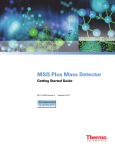Download Nanospray Flex Ion Source Getting Connected
Transcript
Nanospray Flex Ion Source Version 1.0 Getting Connected Guide 60053-97126 Revision A November 2010 © 2010 Thermo Fisher Scientific Inc. All rights reserved. Nanospray Flex, DirectJunction, EASY-nLC, and EASY-Column are trademarks and Xcalibur is a registered trademark of Thermo Fisher Scientifc Inc. in the United States. The following are registered trademarks in the United States: Nanospray is a registered trademark of AB Sciex Pte. Ltd. Lemo is a registered trademark of Interlemo Holding S.A. Dino-Lite is a registered trademark of Anmo Electronics Corporation. Swagelok is a registered trademark of the Crawford Fitting Company. Thermo Fisher Scientific San Jose has a non-exclusive license with the University of Texas for US Patent 5,572,023. Caprioli: Electrospray methods and apparatus for trace analysis. All other trademarks are the property of Thermo Fisher Scientific Inc. and its subsidiaries. Thermo Fisher Scientific Inc. provides this document to its customers with a product purchase to use in the product operation. This document is copyright protected and any reproduction of the whole or any part of this document is strictly prohibited, except with the written authorization of Thermo Fisher Scientific Inc. The contents of this document are subject to change without notice. All technical information in this document is for reference purposes only. System configurations and specifications in this document supersede all previous information received by the purchaser. Thermo Fisher Scientific Inc. makes no representations that this document is complete, accurate or errorfree and assumes no responsibility and will not be liable for any errors, omissions, damage or loss that might result from any use of this document, even if the information in the document is followed properly. This document is not part of any sales contract between Thermo Fisher Scientific Inc. and a purchaser. This document shall in no way govern or modify any Terms and Conditions of Sale, which Terms and Conditions of Sale shall govern all conflicting information between the two documents. Release history: Revision A, November 2010 Software version: EASY-nLC 2.5 and later; Xcalibur 1.3 and later For Research Use Only. Not for use in diagnostic procedures. Regulatory Compliance Thermo Fisher Scientific performs complete testing and evaluation of its products to ensure full compliance with applicable domestic and international regulations. When the system is delivered to you, it meets all pertinent electromagnetic compatibility (EMC) and safety standards as described in the next section or sections by product name. Changes that you make to your system may void compliance with one or more of these EMC and safety standards. Changes to your system include replacing a part or adding components, options, or peripherals not specifically authorized and qualified by Thermo Fisher Scientific. To ensure continued compliance with EMC and safety standards, replacement parts and additional components, options, and peripherals must be ordered from Thermo Fisher Scientific or one of its authorized representatives. FCC Compliance Statement THIS DEVICE COMPLIES WITH PART 15 OF THE FCC RULES. OPERATION IS SUBJECT TO THE FOLLOWING TWO CONDITIONS: (1) THIS DEVICE MAY NOT CAUSE HARMFUL INTERFERENCE, AND (2) THIS DEVICE MUST ACCEPT ANY INTERFERENCE RECEIVED, INCLUDING INTERFERENCE THAT MAY CAUSE UNDESIRED OPERATION. CAUTION Read and understand the various precautionary notes, signs, and symbols contained inside this manual pertaining to the safe use and operation of this product before using the device. Notice on the Proper Use of Thermo Scientific Instruments In compliance with international regulations: Use of this instrument in a manner not specified by Thermo Fisher Scientific could impair any protection provided by the instrument. Notice on the Susceptibility to Electromagnetic Transmissions Your instrument is designed to work in a controlled electromagnetic environment. Do not use radio frequency transmitters, such as mobile phones, in close proximity to the instrument. For manufacturing location, see the label on the instrument. WEEE Compliance This product is required to comply with the European Union’s Waste Electrical & Electronic Equipment (WEEE) Directive 2002/96/EC. It is marked with the following symbol: Thermo Fisher Scientific has contracted with one or more recycling or disposal companies in each European Union (EU) Member State, and these companies should dispose of or recycle this product. See www.thermo.com/ WEEERoHS for further information on Thermo Fisher Scientific’s compliance with these Directives and the recyclers in your country. WEEE Konformität Dieses Produkt muss die EU Waste Electrical & Electronic Equipment (WEEE) Richtlinie 2002/96/EC erfüllen. Das Produkt ist durch folgendes Symbol gekennzeichnet: Thermo Fisher Scientific hat Vereinbarungen mit Verwertungs-/Entsorgungsfirmen in allen EU-Mitgliedsstaaten getroffen, damit dieses Produkt durch diese Firmen wiederverwertet oder entsorgt werden kann. Mehr Information über die Einhaltung dieser Anweisungen durch Thermo Fisher Scientific, über die Verwerter, und weitere Hinweise, die nützlich sind, um die Produkte zu identifizieren, die unter diese RoHS Anweisung fallen, finden sie unter www.thermo.com/WEEERoHS. Conformité DEEE Ce produit doit être conforme à la directive européenne (2002/96/EC) des Déchets d'Equipements Electriques et Electroniques (DEEE). Il est marqué par le symbole suivant: Thermo Fisher Scientific s'est associé avec une ou plusieurs compagnies de recyclage dans chaque état membre de l’union européenne et ce produit devrait être collecté ou recyclé par celles-ci. Davantage d'informations sur la conformité de Thermo Fisher Scientific à ces directives, les recycleurs dans votre pays et les informations sur les produits Thermo Fisher Scientific qui peuvent aider la détection des substances sujettes à la directive RoHS sont disponibles sur www.thermo.com/WEEERoHS. C Contents Preface . . . . . . . . . . . . . . . . . . . . . . . . . . . . . . . . . . . . . . . . . . . . . . . . . . . . . . . . . . . . . . ix Related Documentation . . . . . . . . . . . . . . . . . . . . . . . . . . . . . . . . . . . . . . . . . . .ix Safety and Special Notices . . . . . . . . . . . . . . . . . . . . . . . . . . . . . . . . . . . . . . . . .ix Contacting Us . . . . . . . . . . . . . . . . . . . . . . . . . . . . . . . . . . . . . . . . . . . . . . . . . .xi Disclaimer . . . . . . . . . . . . . . . . . . . . . . . . . . . . . . . . . . . . . . . . . . . . . . . . . . . . .xi Declaration of Conformity . . . . . . . . . . . . . . . . . . . . . . . . . . . . . . . . . . . . . . . . xii Thermo Scientific Chapter 1 Introduction . . . . . . . . . . . . . . . . . . . . . . . . . . . . . . . . . . . . . . . . . . . . . . . . . . . . . . . . . . .1 Content of Nanospray Flex Ion Source Kit . . . . . . . . . . . . . . . . . . . . . . . . . . . . . 2 Unpacking the Ion Source and Preinstallation. . . . . . . . . . . . . . . . . . . . . . . . . . . 3 Installing the Ion Source on the Mass Spectrometer . . . . . . . . . . . . . . . . . . . . . . 5 Chapter 2 Electrical Connections . . . . . . . . . . . . . . . . . . . . . . . . . . . . . . . . . . . . . . . . . . . . . . . . .9 Connecting the Monitor and Cameras . . . . . . . . . . . . . . . . . . . . . . . . . . . . . . . . 9 Adjusting the Monitor and Cameras . . . . . . . . . . . . . . . . . . . . . . . . . . . . . . . . . 11 Chapter 3 DirectJunction Adaptor . . . . . . . . . . . . . . . . . . . . . . . . . . . . . . . . . . . . . . . . . . . . . . . .13 Choosing a One-Column or Two-Column Configuration . . . . . . . . . . . . . . . . 14 Choosing Stainless Steel or Glass Emitters. . . . . . . . . . . . . . . . . . . . . . . . . . . . . 15 Standard Configuration. . . . . . . . . . . . . . . . . . . . . . . . . . . . . . . . . . . . . . . . . . . 16 Assembling the Columns for Standard Configuration . . . . . . . . . . . . . . . . . . 16 Connecting the Columns to a Stainless Steel Emitter . . . . . . . . . . . . . . . . . . 17 Mounting the Column and Emitter Setup onto the DirectJunction Adaptor . . . . . . . . . . . . . . . . . . . . . . . . . . . . . . . . . . . . . . . . . . . . . . . . . . . 18 Connecting the LC System to the Column Setup . . . . . . . . . . . . . . . . . . . . . 19 Connecting the DirectJunction to HV . . . . . . . . . . . . . . . . . . . . . . . . . . . . . 19 Chapter 4 Alternative Configurations for DirectJunction . . . . . . . . . . . . . . . . . . . . . . . . . . . .21 Stainless Steel Emitter and One-Column Setup. . . . . . . . . . . . . . . . . . . . . . . . . 21 Glass Emitter with Liquid Junction and One-Column Setup . . . . . . . . . . . . . . 22 Glass Emitter with Liquid Junction and Two-Column Setup . . . . . . . . . . . . . . 22 Packed Glass Emitter with Liquid Junction in One-Column Setup . . . . . . . . . . 23 Packed Glass Emitter with Liquid Junction in Two-Column Setup. . . . . . . . . . 24 Setup with a Long Analytical Column . . . . . . . . . . . . . . . . . . . . . . . . . . . . . . . . 25 Nanospray Flex Ion Source Getting Connected Guide vii Contents Chapter 5 Nano Flex Ion Source Configuration . . . . . . . . . . . . . . . . . . . . . . . . . . . . . . . . . . . . .27 Chapter 6 Operation . . . . . . . . . . . . . . . . . . . . . . . . . . . . . . . . . . . . . . . . . . . . . . . . . . . . . . . . . . . .33 Positioning the Emitter Tip. . . . . . . . . . . . . . . . . . . . . . . . . . . . . . . . . . . . . . . . 33 Maintaining Stable Spray . . . . . . . . . . . . . . . . . . . . . . . . . . . . . . . . . . . . . . . . . 35 Using the Optional Gas Connection . . . . . . . . . . . . . . . . . . . . . . . . . . . . . . . . . 36 Appendix A Accessories and Spare Parts . . . . . . . . . . . . . . . . . . . . . . . . . . . . . . . . . . . . . . . . . . .37 Nano ES Spray Kit for Offline Analysis. . . . . . . . . . . . . . . . . . . . . . . . . . . . . . . 37 Accessories List . . . . . . . . . . . . . . . . . . . . . . . . . . . . . . . . . . . . . . . . . . . . . . . . . 38 Limited Warranty . . . . . . . . . . . . . . . . . . . . . . . . . . . . . . . . . . . . . . . . . . . . . . . 38 Additional Support . . . . . . . . . . . . . . . . . . . . . . . . . . . . . . . . . . . . . . . . . . . . . . 38 Index . . . . . . . . . . . . . . . . . . . . . . . . . . . . . . . . . . . . . . . . . . . . . . . . . . . . . . . . . . . . . . . .39 viii Nanospray Flex Ion Source Getting Connected Guide Thermo Scientific P Preface This guide provides information on the Thermo™ Nanospray Flex™ ion source, including setup, installation, and operation. The Nanospray Flex ion source works in conjunction with these Thermo Scientific mass spectrometers: • LTQ™ Series: LTQ, Orbitrap™, FT™, Velos™ • Exactive™ • TSQ™ Series: Quantum™, Quantum Access™, Quantum Discovery MAX™, Quantum Ultra™, Vantage™ • LCQ™ Deca XP MAX Contents • Related Documentation • Safety and Special Notices • Contacting Us • Disclaimer • Declaration of Conformity Related Documentation In addition to this guide, Thermo Fisher Scientific provides the following documents for the Nanospray Flex ion source available as PDF files: • Thermo Xcalibur™ manual suite • Ion Max Source and Ion Max-S API Source Hardware Manual The software also provides Help. Safety and Special Notices Make sure you follow the precautionary statements presented in this guide. The safety and other special notices appear in boxes. Thermo Scientific Nanospray Flex Ion Source Getting Connected Guide ix Preface Safety and special notices include the following: CAUTION Highlights hazards to humans, property, or the environment. Each CAUTION notice is accompanied by an appropriate CAUTION symbol. IMPORTANT Highlights information necessary to prevent damage to software, loss of data, or invalid test results; or might contain information that is critical for optimal performance of the system. Note Highlights information of general interest. Tip Highlights helpful information that can make a task easier. CAUTION • Emitter tips are extremely sharp. Never touch the tips as this may cause injury. • Always depressurize the LC-system with transfer line before removing emitters from the source head. Failure to do so may result in the emitter being ejected at high speed. CAUTION • Although the ion source is shielded, in certain cases there might be access to the emitter which is on high voltage (HV). Always turn off the HV before touching the source head. • Never connect a power supply able to deliver more than 8kV and 100 μA to this Nanospray source. • Do not leave the source unattended while the spray voltage is on. CAUTION The interface region, especially the cone of the mass spectrometer can be hot. Do not touch this area. x Nanospray Flex Ion Source Getting Connected Guide Thermo Scientific Preface Contacting Us There are several ways to contact Thermo Fisher Scientific for the information you need. Y To contact Technical Support Phone 800-532-4752 Fax 561-688-8736 E-mail [email protected] Knowledge base www.thermokb.com Find software updates and utilities to download at mssupport.thermo.com. Y To contact Customer Service for ordering information Phone 800-532-4752 Fax 561-688-8731 E-mail [email protected] Web site www.thermo.com/ms Y To get local contact information for sales or service Go to www.thermoscientific.com/wps/portal/ts/contactus. Y To copy manuals from the Internet Go to mssupport.thermo.com, agree to the Terms and Conditions, and then click Customer Manuals in the left margin of the window. Y To suggest changes to documentation or to Help • Fill out a reader survey online at www.surveymonkey.com/s/PQM6P62. • Send an e-mail message to the Technical Publications Editor at [email protected]. Disclaimer • This equipment, including spray capillaries, is designed specifically for creating ions in a mass spectrometer. (No other use is recommended.) • This equipment is for laboratory use only and is not a medical device. • This equipment must not be connected to any power supply delivering more than 8 kV and 100 μA. • Do not allow unauthorized or untrained operators to use this equipment. Thermo Scientific Nanospray Flex Ion Source Getting Connected Guide xi Preface • Any misuse will be the sole responsibility of the user/owner. Thermo Fisher Scientific assumes no implied or inferred liability for direct or consequential damages or injuries from this instrumentation if it is operated or used in any way other than that for which it is designed. • Any legal disagreements must be settled before a Danish court of law. • Only use this equipment if you agree with the conditions above. Declaration of Conformity European Safety Standards Declaration of Conformity Standard(s) to which conformity is declared: IEC 61010-1/ EN61010-1:2001, Second edition - “Safety Requirements for Electrical Equipment for Measurement, Control and Laboratory Use.” Manufacturer’s Name: Proxeon Biosystems A/S Manufacturer’s Address Edisonsvej 4, DK-5000 Odense, Denmark Type of Equipment: Laboratory Instrumentation Model Name: Nanospray Flex ion source Model Numbers: ES071 Serial Number: ES-001000 and later Year of Manufacture: 2010– I, the undersigned hereby declare that the equipment specified above conforms to the above Directive(s) and Standard(s). Ole Vorm, Site Manager xii Nanospray Flex Ion Source Getting Connected Guide October 11, 2010 Thermo Scientific 1 Introduction Nanospray Flex ion sources minimize the liquid flow rate (nL/min) and maintain excellent spray stability to ensure evaporation and ionization of liquid samples —the key to achieving the highest sensitivity. Key benefits of the Nanospray Flex ion source include • User-friendly design • Single setup for all online nanoflow applications • Ability to interface with online nanoscale LC separation techniques Contents • Content of Nanospray Flex Ion Source Kit • Unpacking the Ion Source and Preinstallation • Installing the Ion Source on the Mass Spectrometer Thermo Scientific Nanospray Flex Ion Source Getting Connected Guide 1 1 Introduction Content of Nanospray Flex Ion Source Kit Figure 1. Nanospray Flex ion source Camera with integrated light source and one LCD monitor to visualize emitter position Robust XYZ manipulator for accurate emitter positioning Sliding rails for quick retraction of emitter Easy access to fittings and adaptors for emitters and columns Content of Nanospray Flex Ion Source Kit The Nanospray Flex Ion Source Kit (P/N ES071) includes the following: • Flexible ion source housing with precision XYZ manipulator and fittings • DirectJunction™ adaptor ready for use with a variety of different column/emitter configurations for online analysis • LiquidJunction MicroCross for one column setup with long packed emitters • Dual camera setup including one LCD monitor • Nanobore stainless steel emitters fitting the DirectJunction adaptor 2 Nanospray Flex Ion Source Getting Connected Guide Thermo Scientific 1 Introduction Unpacking the Ion Source and Preinstallation • All necessary cables and connectors for the ion source • Nanospray Flex Ion Source Getting Connected Guide Unpacking the Ion Source and Preinstallation The Nanospray source kit is packed in a single box. To fully protect the components during transport, the source mechanics, DirectJunction adaptor, and cameras are not assembled (see Figure 2). Figure 2. Nanospray ion source components Box with LCD monitor DirectJunction adaptor Screwdrivers Stainless steel emitters LiquidJunction Phono-BNC Dino-Lite cameras Body of Nanospray source Y To unpack the ion source 1. After removing the foam from the top of the box, access the accessories for the Nanospray source. 2. Carefully lift up the next foam bar including the accessories to access the body of the Nanospray source. 3. Carefully take out the body of the Nanospray source and place it on a table to complete the assembly of the Nanospray source. Thermo Scientific Nanospray Flex Ion Source Getting Connected Guide 3 1 Introduction Unpacking the Ion Source and Preinstallation 4. Pull back the drawer of the Nanospray source to access the arm on the XYZ manipulator (see Figure 3). The DirectJunction adaptor has to be mounted to this arm using the 5 mm. screw in the holder of the DirectJunction. Figure 3. Assembly of the DirectJunction to the XYZ manipulator arm DirectJunction adaptor Drawer of the Nanospray source 5 mm screw Arm of the XYZ manipulator 5. Use the supplied screwdriver to mount the DirectJunction adaptor on the XYZ manipulator arm. Before tightening the 5 mm screw, position the DirectJunction with the back of the DirectJunction elevated about 20° above horizontal. Tighten the screw firmly. The two white boxes in the box contain Dino-Lite™ cameras, which are located in the opening on the top and left side of the source body. 6. Loosen the small screw which is used to secure the cameras in place with the supplied screwdriver (see Figure 4). 4 Nanospray Flex Ion Source Getting Connected Guide Thermo Scientific 1 Introduction Installing the Ion Source on the Mass Spectrometer Figure 4. Small screw to fix camera in place Dino-Lite camera placed on top of the source body 7. Remove the cameras and install the first one in the top of the source body. Note that the camera can only be placed one way, ensuring optimal alignment. Slowly tighten the screw until it touches the camera housing. Tighten by another half turn. 8. Repeat the procedure for the second camera, which is located on the left side of the source body. You are now ready to install the Nanospray source. Installing the Ion Source on the Mass Spectrometer After assembling the body and accessories, you are ready to mount the completed source on the mass spectrometer. Thermo Scientific Nanospray Flex Ion Source Getting Connected Guide 5 1 Introduction Installing the Ion Source on the Mass Spectrometer Figure 5. Thermo Nanospray Flex ion source with DirectJunction Y To install the ion source on the mass spectrometer 1. Before removing the previous ion source, disconnect any columns and flow lines from the HPLC system. 2. Refer to the mass spectrometer user manual for guidance on how to remove the existing ion source. 3. Remove the existing ion source as follows: a. Turn the two black handles on top of the source in the direction indicated in Figure 6. The handles might give some resistance. b. Carefully pull out the source. 6 Nanospray Flex Ion Source Getting Connected Guide Thermo Scientific 1 Introduction Installing the Ion Source on the Mass Spectrometer Figure 6. Turning the black handles on top of the ion source Black handles 4. Take the Nanospray source and align the guiding rods of the source with the guiding holes of the mass spectrometer (see Figure 7). 5. Push the source gently towards the mass spectrometer. The top part with the connectors might give some resistance. If so, push a little harder in the top area of the source. 6. Close the two handles by turning them so that they point toward each other (you might feel some resistance). The mass spectrometer is now in Standby mode and the source is mounted. Thermo Scientific Nanospray Flex Ion Source Getting Connected Guide 7 1 Introduction Installing the Ion Source on the Mass Spectrometer Figure 7. Guiding holes on the Nanospray source for mounting on the guiding rods of the mass spectrometer Multi pole connector for the Interlock and source recognition HV connector Guiding rods 8 Nanospray Flex Ion Source Getting Connected Guide Guiding holes Thermo Scientific 2 Electrical Connections For correct operation, use these procedures to connect the cameras and monitor electrically and to adjust the focus for sharp pictures. Contents • Connecting the Monitor and Cameras • Adjusting the Monitor and Cameras CAUTION When you push the XYZ manipulator onto the mounting frame of the source, the HV for the spray emitter switches on. For your protection, always retract the drawer of the source before working with the source head. You must use the supplied HV cables and connectors in the Nanospray Flex ion source. Connecting the Monitor and Cameras After installing the Thermo Nanospray Flex ion source, you must set up the LCD monitor and Dino-Lite cameras. Y To connect and adjust the LCD monitor and Dino-Lite cameras 1. In the ion source kit, remove the monitor from the brown box and place it on top of the mass spectrometer by using the support arm on the back of the monitor (see Figure 8.) Thermo Scientific Nanospray Flex Ion Source Getting Connected Guide 9 2 Electrical Connections Connecting the Monitor and Cameras Figure 8. Back of LCD monitor Video connectors for the Dino-Lite cameras BNC adaptors Video-IN for the cameras 12 V power supply connector for the LCD monitor 2. Connect the 12 V power supply connector to the monitor. 3. Locate the two BNC adaptors in the ion source kit and, using a quarter-turn, insert them into the two Video-IN ports on the back of the monitor (Figure 8). 4. Connect the two yellow video connectors from the Dino-Lite cameras onto the two BNC adaptors. 5. Choose and insert the appropriate connector to the power supply: a. Locate the power supply for the cameras in the camera box. The power supply comes equipped with an EU standard net connector. The kit box contains one U.K. and one U.S. connector. b. Connect the low-voltage connectors of the two power supplies to the two Dino-Lite camera power connectors (see Figure 9). 10 Nanospray Flex Ion Source Getting Connected Guide Thermo Scientific 2 Electrical Connections Adjusting the Monitor and Cameras Figure 9. Connection of the low-voltage connectors to the camera power connectors Dino-Lite camera power connectors Low-voltage connectors on the power supply for the cameras 6. Connect the power adaptors for the two Dino-Lite cameras and the power adaptor for the monitor to your net power sockets. The cameras and the monitor are now ready for use. Adjusting the Monitor and Cameras Y To adjust the LCD monitor and Dino-Lite cameras 1. Turn on the LCD monitor by pressing the POWER button on the front of the monitor (see Figure 10). Figure 10. LCD Monitor setup and control panel Power button Switch between cameras After a few seconds the picture from one of the two cameras appears. The picture is likely to be very blurred. Thermo Scientific Nanospray Flex Ion Source Getting Connected Guide 11 2 Electrical Connections Adjusting the Monitor and Cameras 2. Adjust the focus with the focusing wheel (Figure 4). Figure 11. Camera light source switch and focusing wheel Switch for the light source in the camera Focusing wheel The adjustments produce a sharp image on the monitor: 3. Switch to the second camera by pressing the SOURCE button (see Figure 10 on page 11), and adjust the focus with the focusing wheel as above. 4. If the picture on the LCD monitor is too dark, use the camera’s internal light to make adjustments. a. To turn on the light, gently press the small button on the back of either camera (Figure 4). b. Adjust the picture to achieve the sharpest image by using either camera light or both lights together. 12 Nanospray Flex Ion Source Getting Connected Guide Thermo Scientific 3 DirectJunction Adaptor DirectJunction is a configurable adaptor for the Thermo Nanospray Flex ion source (see Figure 12). It enables the flexible interchange between most online column and emitter configurations, and uses stainless steel or glass emitters and a one-column or two-column setup, with or without a liquid junction. Contents • Choosing a One-Column or Two-Column Configuration • Choosing Stainless Steel or Glass Emitters • Standard Configuration • Connecting the DirectJunction to HV Thermo Scientific Nanospray Flex Ion Source Getting Connected Guide 13 3 DirectJunction Adaptor Choosing a One-Column or Two-Column Configuration Figure 12. DirectJunction adaptor HV clamp for stainless steel or coated glass emitters ZDV union for connecting the column and emitter HV protection shield Mounting bracket for the Nanospray ion source Multipurpose adaptor for ZDV unions, liquid junctions, and connecting tees Choosing a One-Column or Two-Column Configuration The DirectJunction adaptor supports both a one- and two-column configuration. A one-column configuration has the following advantages: • It has fewer connections, which minimize any potential peak broadening that results from dead volumes. • It enables MS analysis of compounds that elute during sample loading (as they might not bind to the column material) because the fluid path leads directly to the MS. 14 Nanospray Flex Ion Source Getting Connected Guide Thermo Scientific 3 DirectJunction Adaptor Choosing Stainless Steel or Glass Emitters A two-column setup (typically a short pre/trap-column with a large inner diameter and a longer analytical column with a narrower inner diameter) has these advantages: • A pre/trap-column provides an increased loading capacity and an increased loading flow rate when compared to loading directly onto the analytical column. • It directs the loading solvent to waste so that sample “contaminants” do not enter the MS, reducing the need to clean the MS inlet. • A pre/trap-column acts as a guard column by protecting the analytical column from particulate matter. Choosing Stainless Steel or Glass Emitters Stainless steel emitters are more robust than glass emitters, and help to maintain a stable and consistent spray for longer periods of time. The DirectJunction adaptor enables high voltage (HV) to be applied directly to the stainless steel emitter through the small HV clamp at the front of the adaptor. By applying voltage across the entire emitter, you can maintain a constant optimal electrical contact with the liquid. The result is superior spray stability. A cross section of scientists consider glass emitters to be more bio-inert than stainless steel emitters. This state means reducing the risk of non-specific adsorption of biomolecules and leads to slightly improved sensitivity. However, the degree of this adsorption depends on the chemical characteristics of the sample. You can pull glass emitters to produce very small ID emitter openings. However, the very small opening at the tip often results in stability problems associated with blockage of the tip, and means that glass emitters rarely last as long as their steel counterparts. Glass emitters usually have HV applied through a liquid junction. This means that only a small percentage of the bulk liquid flow is exposed to the electrode carrying the HV. Tip When using glass emitters, do the following: • Place the liquid junction at the high-pressure side of the column. Electrochemical processes occurring at the electrode can otherwise create gas that leads to spray instability. • Use glass emitters with small ID emitter tips (<20 μm) to create back pressure in the emitter and avoid outgassing and consequent spray instability. Thermo Scientific Nanospray Flex Ion Source Getting Connected Guide 15 3 DirectJunction Adaptor Standard Configuration Standard Configuration Figure 13 shows the recommended configuration for the EASY-nLC™ nano-flow liquid chromatography system and EASY-Columns™ with a stainless steel emitter installed on the DirectJunction prior to mounting onto the Nanospray Flex ion source. Figure 13. Configuration for the EASY-nLC and EASY-Columns on DirectJunction using a stainless steel emitter Stainless steel emitter (ES542) EASY-Column (SC200) 10 cm, 75 μm ID, 3 μm C18 media EASY-nLC “Waste in” line (1/32 in. OD) Venting tee for two-column setup (for 1/32 in. OD tubing) (SC601) EASY-Column (SC001) 2 cm, 100 μm ID, 3 μm C18 media EASY-nLC “Column out” line (1/32 in. OD) Zero-dead-volume union (for 1/32 in. OD tubing) (SC600) Assembling the Columns for Standard Configuration Y To assemble the pre-column and analytical column 1. Remove both red nuts from the ZDV union (SC600). 2. Screw the white blind plug into the union. Figure 14. ZDV union with white blind plug (SC600) 3. Insert the pre-column (SC001) through a 2 cm (0.79 in.) 1/32 in. OD sleeve (F-385) with arrows on the label pointing away from the sleeve. 16 Nanospray Flex Ion Source Getting Connected Guide Thermo Scientific 3 DirectJunction Adaptor Standard Configuration 4. Insert the sleeved pre-column through a red nut. 5. Screw in the red nut while ensuring that the pre-column and sleeve are firmly pushed against the white blind plug. 6. Insert the other end of the pre-column through a 1/32 in. OD sleeve (F-385), ferrule, and nut from the venting tee (SC601). Figure 15. ZDV union (SC600) and pre-column (SC001) assembly 7. Tighten the nut while ensuring that the pre-column and sleeve are firmly pushed against the center of the venting tee. 8. Install the analytical column on the other side of the venting tee using a 1/32 in. OD sleeve (F385). Check the label for the flow, and firmly push the sleeve and column against the center of the venting tee. Figure 16. ZDV union (SC600), pre-column (SC001), venting tee (SC601), and analytical column (SC200) assembly Connecting the Columns to a Stainless Steel Emitter Y To connect the columns to a stainless steel emitter 1. Remove both red nuts from a second ZDV union (SC600). 2. Insert the white blind plug into the union. 3. Insert the outlet end of the analytical column through a 1/32 in. OD sleeve (F385) and a red nut. 4. Screw the outlet end into the union, ensuring that the column and sleeve are firmly pushed against the white blind plug. Then, remove the white blind plug. 5. Insert the sleeved emitter (ES542) through a red nut. Thermo Scientific Nanospray Flex Ion Source Getting Connected Guide 17 3 DirectJunction Adaptor Standard Configuration 6. Screw the sleeved emitter into the other end of the union, ensuring that the emitter and sleeve are firmly pressed against the column outlet and sleeve. Figure 17. Stainless steel emitter with 1/32 inch sleeve (ES542) Figure 18. ZDV union assembly between analytical column and stainless steel emitter Mounting the Column and Emitter Setup onto the DirectJunction Adaptor Y To mount the column and emitter setup onto the DirectJunction adaptor 1. Mount the DirectJunction adaptor onto the Nanospray ion source. 2. Connect the red HV cable to the banana plug on the DirectJunction adaptor. 3. Open the front HV clamp on the DirectJunction adaptor. 4. Mount the ZDV union connecting the emitter and analytical column in the black holder onto the DirectJunction adaptor, and close the clamp over the emitter. 5. Adjust the position of the multipurpose adaptor on the steel rod, and mount the venting tee in the adaptor. Figure 19. DirectJunction adaptor with two-column setup and steel emitter mounted on a Nanospray Flex ion source 18 Nanospray Flex Ion Source Getting Connected Guide Thermo Scientific 3 DirectJunction Adaptor Standard Configuration Connecting the LC System to the Column Setup Y To connect the LC system to the column setup 1. Connect the “Column out” line from the EASY-nLC system to the pre-column through the ZDV union, ensuring the line is firmly pushed against the pre-column and sleeve. 2. Connect the “Waste in” line from the EASY-nLC system to the third port on the venting tee. Figure 20. DirectJunction adaptor (as in Figure 19) but with “Column out” and “Waste in” flow lines connected from the EASY-nLC system Connecting the DirectJunction to HV Make sure that the high voltage connector of the DirectJunction adaptor is inserted into the Lemo™ HV socket on the underside of the Nanospray ion source drawer. Figure 21. DirectJunction adaptor Nanospray ion source drawer DirectJunction high voltage connector Thermo Scientific Nanospray Flex Ion Source Getting Connected Guide 19 4 Alternative Configurations for DirectJunction Depending on the specific experimental requirements on columns, emitters, and connections, the following configurations might work well in different situations. Contents • Stainless Steel Emitter and One-Column Setup • Glass Emitter with Liquid Junction and One-Column Setup • Glass Emitter with Liquid Junction and Two-Column Setup • Packed Glass Emitter with Liquid Junction in One-Column Setup • Packed Glass Emitter with Liquid Junction in Two-Column Setup • Setup with a Long Analytical Column Stainless Steel Emitter and One-Column Setup Figure 22. Stainless steel emitter with one column ES542 Analytical column To waste SC601 Transfer line Note EASY-nLC software version 2.5 and later require use of the “Waste in” line connected to the vent (SC601) upstream of the analytical column in one-column configurations. Thermo Scientific Nanospray Flex Ion Source Getting Connected Guide 21 4 Alternative Configurations for DirectJunction Glass Emitter with Liquid Junction and One-Column Setup For earlier software versions or with other LC systems, you can replace the venting tee with a ZDV union (SC600). Glass Emitter with Liquid Junction and One-Column Setup Figure 23. Glass emitter with a liquid junction and one column Glass emitter Analytical column To waste ES257 Transfer line Note EASY-nLC software version 2.5 and later require use of the “Waste in” line connected to the vent (ES257) upstream of the analytical column in one-column configurations. For earlier software versions or with other LC systems, you can replace the Liquid Junction Cross (ES257) with a Liquid Junction Tee (ES258). Use small ID emitter tips (<20 μm) to prevent out gassing in the tip and subsequent spray instability. Glass Emitter with Liquid Junction and Two-Column Setup Figure 24. Glass emitter with a liquid junction and two columns Glass emitter Analytical column To waste ES257 SC600 Transfer line SC001 22 Nanospray Flex Ion Source Getting Connected Guide Thermo Scientific 4 Alternative Configurations for DirectJunction Packed Glass Emitter with Liquid Junction in One-Column Setup Note Use small ID emitter tips (<20 μm) to prevent out gassing in the tip and subsequent spray instability. Packed Glass Emitter with Liquid Junction in One-Column Setup Figure 25. Packed glass emitter with a liquid junction and one column Packed glass emitter Transfer line To waste ES257 Note The packed glass emitter contains the stationary phase and has dual roles: as the analytical column and the emitter. The packed glass emitter is inserted through the ZDV union, which only serves as positional support. Note EASY-nLC software version 2.5 and later require use of the “Waste in” line connected to the vent (ES257) upstream of the analytical column in one-column configurations. In earlier software versions or with other LC systems, you can replace the Liquid Junction Cross (ES257) with a Liquid Junction Tee (ES258). Thermo Scientific Nanospray Flex Ion Source Getting Connected Guide 23 4 Alternative Configurations for DirectJunction Packed Glass Emitter with Liquid Junction in Two-Column Setup Packed Glass Emitter with Liquid Junction in Two-Column Setup Figure 26. Packed glass emitter with a liquid junction and two columns Packed glass emitter To waste ES257 SC600 Transfer line SC001 Note The packed glass emitter contains the stationary phase and has dual roles: as the analytical column and the emitter. The packed glass emitter is inserted through the ZDV union, which only serves as positional support. 24 Nanospray Flex Ion Source Getting Connected Guide Thermo Scientific 4 Alternative Configurations for DirectJunction Setup with a Long Analytical Column Setup with a Long Analytical Column Figure 27. Long analytical column Glass emitter Long analytical column (>20 cm) To waste Transfer line ES257 Transfer line Note You can easily fit long columns to the DirectJunction adaptor by coiling them between the ZDV union and the vent (ES257). Figure 27 shows a glass emitter and a liquid junction, but combinations with a steel emitter, a two-column configuration, or both of these are also possible. Note EASY-nLC software version 2.5 and later require use of the “Waste in” line connected to the vent (ES257) upstream of the analytical column in one-column configurations. In earlier software versions or with other LC systems, you can replace the Liquid Junction Cross (ES257) with a Liquid Junction Tee (ES258). Use small ID emitter tips (<20 μm) to prevent out gassing in the tip and subsequent spray instability. Thermo Scientific Nanospray Flex Ion Source Getting Connected Guide 25 5 Nano Flex Ion Source Configuration When analyzing with nanospray sources, you only need to change a few mass spectrometer settings in the Xcalibur data sytem. The MS software will automatically recognize the ion source type. Y To specify configuration options for the ion source 1. Open the Instrument Configuration window from the computer desktop as follows: • For Xcalibur 2.0.7 or earlier versions, choose Start > All Programs > Xcalibur > Instrument Configuration. Or, double-click the Instrument Configuration icon. • For Xcalibur 2.1.0 or later versions, choose Start > All Programs > Thermo Foundation 1.0 > Instrument Configuration. The [Thermo Foundation] Instrument Configuration window appears with a list of the installed available devices (see Figure 28). Thermo Scientific Nanospray Flex Ion Source Getting Connected Guide 27 5 Nano Flex Ion Source Configuration Figure 28. Thermo Foundation Instrument Configuration window 2. Double-click the icon that represents your MS system (for example, LXQ MS). A copy of the icon appears in the Configured Devices pane. 3. Complete the configuration of the mass spectrometer as follows: a. In the Configured Devices pane, double-click the LXQ MS icon (or the icon for your system). The LXQ Configuration dialog box appears (see Figure 29). 28 Nanospray Flex Ion Source Getting Connected Guide Thermo Scientific 5 Nano Flex Ion Source Configuration Figure 29. LXQ Configuration dialog box b. Select Ion Source in the left pane if it is not already selected. c. Ensure that the default source is Nanospray (the instrument recognizes the source automatically). If the source is not correct, follow the instructions in the Xcalibur manual. d. Click OK to close the window. 4. From your desktop, double-click the LXQ Tune icon (or the correct system name of your MS). The Thermo Tune Plus window opens where you can analyze and choose specific settings (see Figure 30). Thermo Scientific Nanospray Flex Ion Source Getting Connected Guide 29 5 Nano Flex Ion Source Configuration Figure 30. Thermo Tune Plus window 5. From the main menu, choose Setup > NSI Source. The NSI source dialog box opens. Figure 31. NSI Source dialog box 30 Nanospray Flex Ion Source Getting Connected Guide Thermo Scientific 5 Nano Flex Ion Source Configuration 6. Set the ion spray voltage for nanospray analysis. Pay attention to these nanospray-specific settings: • For online analysis: I Spray Voltage (kV): 1.40 to 2.40 (Start with 1.80 kV.) • For offline analysis: I Spray Voltage (kV): 0.70 to 1.20 (Start with 0.90 kV.) 7. Click OK. Note Before you begin nanospray analysis, check that the drawer of the Nanospray Flex ion source is pushed completely toward the frame; otherwise, a message that the source is open appears and the MS will not scan. The Nanospray Flex ion source is now be ready for analysis. Thermo Scientific Nanospray Flex Ion Source Getting Connected Guide 31 6 Operation Both for intial setup and regular maintenance, use these procedures to monitor the position of the emitter tip and the spray voltage/current for optimal performance. Contents • Positioning the Emitter Tip • Maintaining Stable Spray • Using the Optional Gas Connection Positioning the Emitter Tip The correct position of the emitter tip is an important parameter in nano ES analysis. Y To optimize the position of the emitter tip 1. Position the spray capillary tip almost on-axis with the orifice by using the four knobs on the XYZ manipulator (see Figure 32). 2. As you make adjustments, observe the magnified inlet/orifice on the monitor. Thermo Scientific Nanospray Flex Ion Source Getting Connected Guide 33 6 Operation Positioning the Emitter Tip Figure 32. Adjustment knobs on the XYZ manipulator Left-right adjustment (sideward movement of the emitter) Vertical adjustment of the emitter Adjustment toward the orifice Fine adjustment toward the orifice CAUTION Emitter tips are extremely sharp. Never touch the tips as this may cause injury. CAUTION • Although the ion source is shielded, there is easy access to the source head. • Always turn off the high voltage before touching the source head. Do not leave the source unattended while the spray voltage is on. • Always mount the high voltage insulator correctly before turning on the high voltage. • The interface region of the mass spectrometer can be hot. Do not touch this area. Figure 33 illustrates some important settings whose values can vary depending on the mass spectrometer in use. Also, the optimal distance between the emitter tip and orifice depends on the flow rate, as does the optimal potential on the emitter. 34 Nanospray Flex Ion Source Getting Connected Guide Thermo Scientific 6 Operation Maintaining Stable Spray Figure 33. Schematic setup of the ion source and the mass spectrometer interface Sample from HPLC system Inlet of MS Stainless steel or fused silica emitter 0–20° Optimal flow rate between 50 and 500 nL/min A Values for stainless steel or fused silica emitters: A = 3 to 5 mm and the potential on the emitter, 1400 to 2400 V Maintaining Stable Spray For best results, use stainless steel emitters for nano electrospray experiments. These emitters ensure straightforward initiation of the spray and help to maintain spray stability over extended periods (up to 1000 hours). Unstable spray is detrimental to most analyses. Table 1 lists the most common reasons for unstable spray and ways to correct it. Table 1. Correcting unstable electrospray Thermo Scientific Cause Possible correction The HV contact is interrupted. Check/clean the gold contact in the HV clamp where the emitter is held in the DirectJunction adaptor. Check the red cable and connectors. Check if the mass spectrometer is supplying the correct high voltage. Air bubbles in the emitter (if glass) might cause the emitter to “spit.” Check if the solvents are degassed properly. The emitter is blocked because of particulates in the sample, other small particles from the flow lines/valves, and so on. (Stainless steel emitter only) If sonicating the emitter does not remove the blockage, replace the emitter. There is a leak at some point in the liquid path. Check if the correct flow is being delivered. Nanospray Flex Ion Source Getting Connected Guide 35 6 Operation Using the Optional Gas Connection Using the Optional Gas Connection The drawer of the Nanospray Flex ion source is equipped with a gas connector, a Swagelok™ fitting for tubing with 1/8" (OD). Figure 34. Swagelok 1/8” gas connector, option for drying- or curtain gas. In research analyses, use this optional gas connection for drying gas when you want to work in a controlled environment around the spray area. 36 Nanospray Flex Ion Source Getting Connected Guide Thermo Scientific A Accessories and Spare Parts This appendix provides ordering information for the Nano ES Spray Kit for offline analysis, and spare parts and accessories for the Thermo Nanospray Flex ion source. For detailed descriptions and ordering information on the full range of spare parts and accessories for the Nanospray Flex ion source, visit www.proxeon.com. Contents • Nano ES Spray Kit for Offline Analysis • Accessories List • Limited Warranty • Additional Support Nano ES Spray Kit for Offline Analysis Through offline analysis, you can extract the maximum amount of information from very limited amounts of sample. You can also average data extensively to improve the S/N-ratio and conditions optimized for MS/MS experiments. Using the Nano ES Spray Kit (see Figure 35), you can do the following: • Work at low flow rates of 10–40 nL/min. • Utilize nearly 100 percent of sample. • Work effectively with sample volumes down to 300 nL. • Avoid cross contamination by using disposable emitters. • Spray from purely aqueous as well as purely organic solvents. Thermo Scientific Nanospray Flex Ion Source Getting Connected Guide 37 A Accessories and Spare Parts Accessories List The Nano ES Spray Kit includes all necessary items for offline analysis. The kit is not included with the Nanospray Flex ion source but can be ordered separately. Figure 35. ES259 offline Nano ES Spray Kit Accessories List This section lists the part numbers for the followingNanospray Flex ion source accessories: DirectJunction . . . . . . . . . . . . . . . . . . . . . . . . . . . . . . . . . . . . . . . . . . . . . . . . . . . . . . ES256 LiquidJunction with Cross 1/32 in. . . . . . . . . . . . . . . . . . . . . . . . . . . . . . . . . . . . . . . . ES257 LiquidJunction with Tee 1/32 in. . . . . . . . . . . . . . . . . . . . . . . . . . . . . . . . . . . . . . . . . ES258 Off-line source head kit. . . . . . . . . . . . . . . . . . . . . . . . . . . . . . . . . . . . . . . . . . . . . . . . ES259 One Dino-Lite video camera . . . . . . . . . . . . . . . . . . . . . . . . . . . . . . . . . . . . . . . . . . . ES216 One LCD Monitor 8 in. . . . . . . . . . . . . . . . . . . . . . . . . . . . . . . . . . . . . . . . . . . . . . . . ES217 Limited Warranty • Thermo Fisher Scientific limits the warranty on repair of supplied Nano ES equipment and replacement, provided that instrument operation has been in accordance with the instructions outlined in the instruction manual. • Abuse or misuse of the Nano ES equipment, or unauthorized repairs void this warranty. • Limited warranty work is performed only at the factory, and the user bears the cost of shipment to and from the factory. • The limited warranty is as stated above and no implied or inferred liability for direct or consequential damage is intended. Additional Support For further assistance, go to www.proxeon.com and click Support and Service in the left margin of the window. 38 Nanospray Flex Ion Source Getting Connected Guide Thermo Scientific I Index A BNC adaptor 10 emitter glass liquid junction, one-column setup 22 liquid junction, two-column setup 22 packed glass liquid junction, one-column setup 23 liquid junction, two-column setup 24 stainless steel and one-column setup 21 emitter tip (caution) 34 C F camera adjusting 11 Dino-Lite 9 column and emitter setup 18 column setup, long analytical 25 compliance FCC iii regulatory iii WEEE v components, ion source 3 configuring the ion source 27 FCC compliance iii accessories 38 adaptor See DirectJunction analysis, offline 37 B D declaration of conformity xii DirectJunction alternative configurations 21 column and emitter setup 18 description 13 HV connection 19 mounting 4 Disclaimer xi E electromagnetic compatibility iii EMC compliance iii Thermo Scientific G gas connector 36 H HV cables and connectors 9 I installation, ion source on MS 5 instrument configuration window (Xcalibur) 27 ion source removing existing 6 ion source - MS schematic 35 ion source kit, contents 2 M mass spectrometers, ion source compatible ix monitor (LCD) adjusting 11 connecting to cameras 9 O offline analysis 37 online/offline analysis 31 Nanospray Flex Ion Source Getting Connected Guide 39 Index: P P positioning, emitter tip 33 power supply and connectors 10 preinstallation, ion source 3 R regulatory compliance iii S safety standards iii spare parts 37 spray capillary 33 spray stability, maintaining 35 U unpacking the ion source See preinstallation, ion source W warranty information 38 WEEE compliance v X Xcalibur, settings for ion source 27 XYZ manipulator 2, 33 XYZ manipulator (caution) 9 40 Nanospray Flex Ion Source Getting Connected Guide Thermo Scientific




















































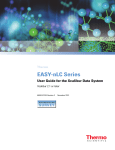

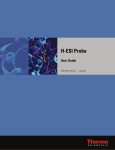
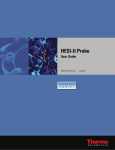





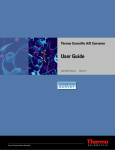
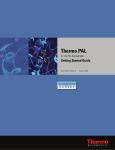
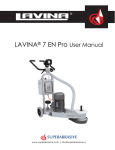


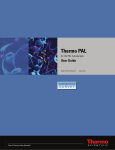
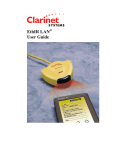
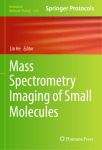
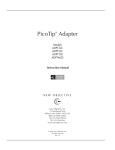
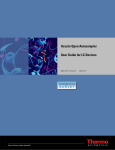
![HESI-II Probe User Guide Version B [FR]](http://vs1.manualzilla.com/store/data/006386286_1-8171fb8e5aed207e113b253f1be7db83-150x150.png)
